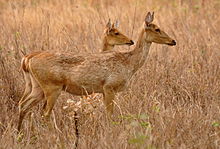| Barasingha | |
|---|---|

| |
| Male | |

| |
| Adult female and yearling | |
| Scientific classification | |
| Domain: | Eukaryota |
| Kingdom: | Animalia |
| Phylum: | Chordata |
| Class: | Mammalia |
| Order: | Artiodactyla |
| Family: | Cervidae |
| Genus: | Rucervus |
| Species: | R. duvaucelii
|
| Binomial name | |
| Rucervus duvaucelii | |

| |
| Historic range (yellow); relict populations: duvaucelii (red); branderi (green); ranjitsinhi (blue) | |
The barasingha (Rucervus duvaucelii), sometimes barasinghe, also known as the swamp deer, is a deer species distributed in the Indian subcontinent. Populations in northern and central India are fragmented, and two isolated populations occur in southwestern Nepal. It has been extirpated in Pakistan and Bangladesh, and its presence is uncertain in Bhutan.[1]
The specific name commemorates the French naturalist Alfred Duvaucel.[3]
The swamp deer differs from all other Indian deer species in that the antlers carry more than three tines. Because of this distinctive character it is designated bārah-singgā, meaning "twelve-horned" in Hindi.[4] Mature stags usually have 10 to 14 tines, and some have been known to have up to 20.[5]
In Assamese, barasingha is called dolhorina; dol meaning swamp.
- ^ a b c Duckworth, J.W.; Kumar, N.S.; Pokharel, C.P.; Sagar Baral, H. & Timmins, R. (2015). "Rucervus duvaucelii". IUCN Red List of Threatened Species. 2015: e.T4257A22167675. doi:10.2305/IUCN.UK.2015-4.RLTS.T4257A22167675.en. Retrieved 15 January 2022.
- ^ Grubb, P. (2005). "Species Rucervus duvaucelii". In Wilson, D.E.; Reeder, D.M (eds.). Mammal Species of the World: A Taxonomic and Geographic Reference (3rd ed.). Johns Hopkins University Press. pp. 668–669. ISBN 978-0-8018-8221-0. OCLC 62265494.
- ^ Cuvier, G. (1823). Recherches sur les ossemens fossiles de quadrupèdes. Vol. Tome Quatrième (Nouvelle édition ed.). Paris, Amsterdam: Dufour & d'Ocagne.
- ^ Lydekker, R. (1888–1890). The new natural history Volume 2. Printed by order of the Trustees of the British Museum (Natural History), London.
- ^ Prater, S. H. (1948). The book of Indian animals. Oxford University Press. (10th ed.)
